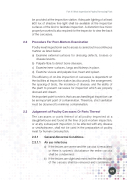Part 4 | Meat Inspection In Poultry Processing Plant be provided at the inspection station. Adequate lighting of at least 600 lux of shadow free light shall be available at the inspection surfaces of the bird to facilitate inspection. A distortion free mirror properly mounted is also required for the inspector to view the back of the carcasses. 2.2 Procedure For Post-Mortem Examination Poultry meat inspection in each carcass is carried out in a continuous manner as listed below: a) Examine external surfaces for dressing defects, bruises or disease lesions. b) Palpate tibia to detect bone diseases. c) Examine inner surfaces, lungs and kidneys in place. d) Examine viscera and palpate liver, heart and spleen. The ef ciency of on-line inspection of carcasses is dependent on the facilities at inspection station (as discussed), line arrangement, the spacing of birds, the incidence of disease, and the ability of the plant to present carcasses for inspection which are properly dressed and drawn. An important point to note is that carcass handling at inspection can be an important point of contamination. Therefore, strict sanitation must be observed to minimise contamination. 2.3 Judgement of Poultry Carcasses Or Parts Thereof The carcasses or parts thereof of all poultry inspected at a slaughterhouse and found at the time of post-mortem inspection, or at any subsequent inspection, to be affected with any disease or unwholesome, shall not be used in the preparation of poultry meat for human consumption. 2.3.1 General Abnormal Conditions 2.3.1.1 Air sac infections a) If the lesions are severe and the carcass is emaciated or there is systemic disturbance the entire carcass shall be condemned. b) Ifthelesionsareslightandrestrictedtheaffectedpart of the carcass shall be removed and condemned, 69
